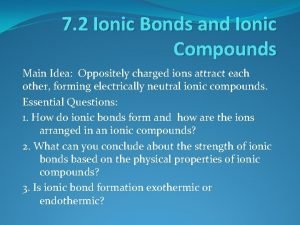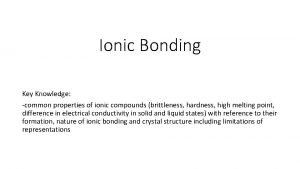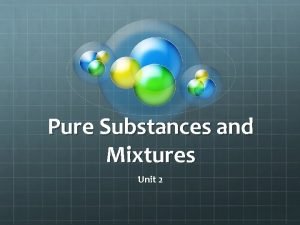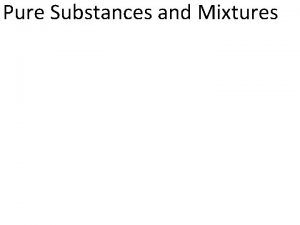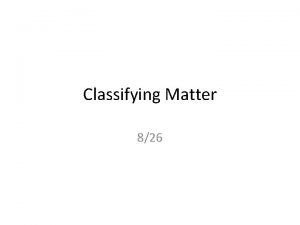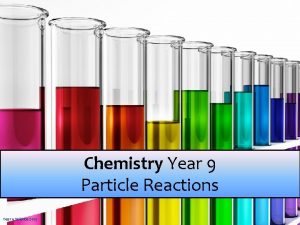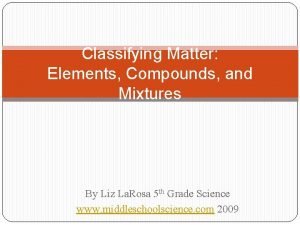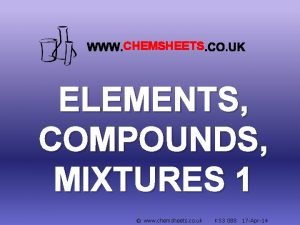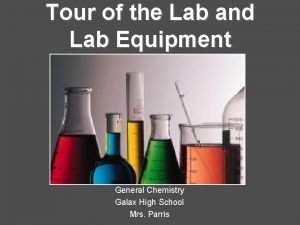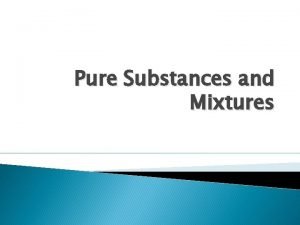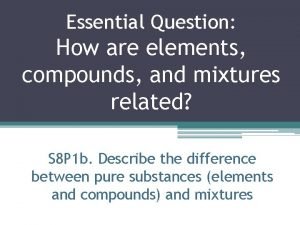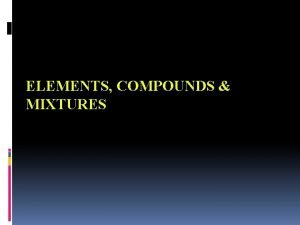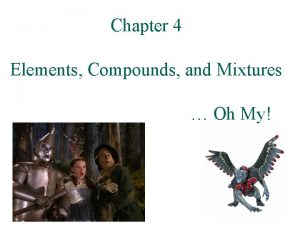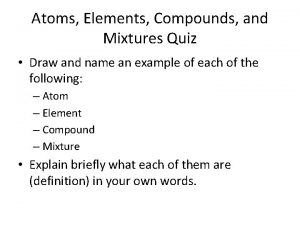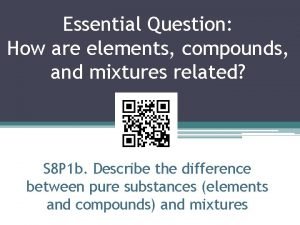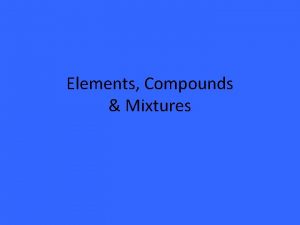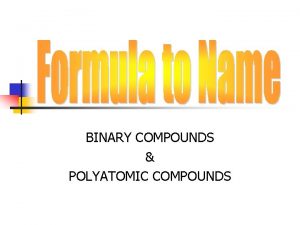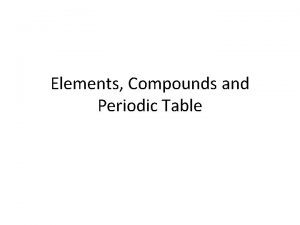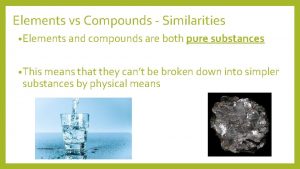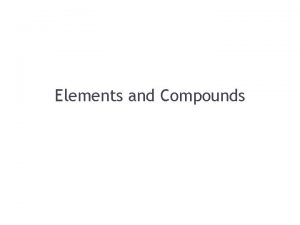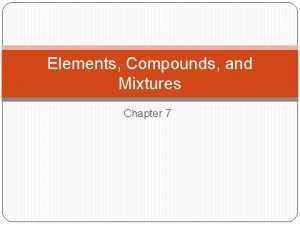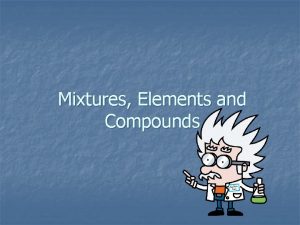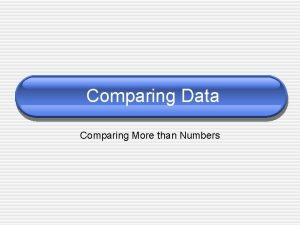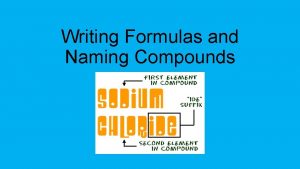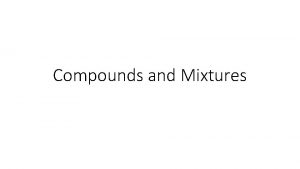Comparing elements and compounds Properties of elements and






















- Slides: 22

Comparing elements and compounds

Properties of elements and compounds Why is it safe to put sodium chloride on fish and chips… …but not safe to use sodium and chlorine?

Atoms in elements and compounds Elements are materials made up of one type of atom only. The element, hydrogen, exists as molecules. Each hydrogen molecule is made up of two hydrogen atoms joined together. The compound, water, exists as molecules. Each water molecule consists of two hydrogen atoms joined to one oxygen atom. H H

Making a compound – water A compound is made when atoms of different elements react and join together. For example, water is produced from the chemical reaction between hydrogen and oxygen. hydrogen + oxygen water Two hydrogen molecules react with one oxygen molecule to produce two molecules of water. Why does water have different properties to its elements?

Properties of a compound – carbon dioxide A compound has different properties to the elements from which it is made because the atoms are joined differently. carbon + oxygen carbon dioxide + Black solid used as fuel. C Colourless gas in which many substances burn. + O O Colourless gas used in fizzy drinks and fire extinguishers.

A compound is not a mixture The atoms in a mixture of hydrogen gas and oxygen gas, which have not reacted with each other, look like this… The atoms in water, the compound made when hydrogen and oxygen react and their atoms become chemically joined to each other, look like this…

Compound names and formulae To name simple compounds of metals and non-metals: 1. Write down the name of the metal. 2. Write down the name of the non-metal, changing the ending of the word to “-ide”. What is the name of the compound made when the following elements combine?

Naming simple compounds Many compounds contain more than two elements. For compounds containing two elements plus oxygen, the ending of the other non-metal usually changes to “-ate”.

Composition of compounds A compound contains atoms from different elements that are chemically joined together. A compound always contains a particular amount of each element. It has a fixed composition. Compound names can get quite long and complicated, so the symbols of the elements are used as a shorthand. The symbols of the elements in a compound are combined to give the formula of the compound. What is the formula of carbon dioxide?

A formula uses the symbols of the elements in a compound. When there is more than one atom of each element, the number is always written after the symbol. The formula shows the ratio of atoms in a compound.

What is the formula? What is the formula of each of these compounds? (In a formula put the metal first as when naming a compound. ) 1. Titanium oxide For every titanium atom there are two oxygen atoms. Formula = 2. Lithium oxide For every two lithium atoms there is one oxygen atom. Formula = 3. Aluminium chloride For every aluminium atom there are three chlorine atoms. Formula =

What is the formula? What is the formula of each of these compounds? (In a formula put the metal first as when naming a compound. ) 1. Silicon chloride For every silicon atom there are four chlorine atoms. Formula = 2. Manganese oxide For every manganese atom there are two oxygen atoms. Formula = 3. Aluminium oxide For every two aluminium atoms there are three oxygen atoms. Formula =

What does a formula show?

Word equations A word equation can be used to describe any chemical reaction, i. e. any process in which atoms become joined in different ways. The steps for writing a word equation are: 1. On the right-handside, put the name of the reactant(s). If there are two or more reactants, link them with a + sign. 2. In the middle, write down an arrow ( ). 3. On the right-handside, put the name of the product(s). If there are two or more products, link them with a + sign.

What is the word equation? Lead reacts with oxygen to form lead oxide. What is the word equation for this reaction? lead + oxygen � lead oxide Why is lead oxide so different to both lead and oxygen? The lead and oxygen don’t mix, they react to form lead oxide. This means that the lead and oxygen atoms in the product are joined differently to the atoms in the reactants.

What is the word equation?


What is a mixture? A mixture contains two or more substances that are mixed together but have not reacted with each other. Sea water is a mixture of salts, water and other substances. A mixture is not the same as a compound: 1. The proportions of the substances in a mixture are not fixed. 2. The properties of a mixture are often an “average” of the properties of its ingredients (e. g. a mixture of a black and white powder is grey). 3. The substances in a mixture are just mixed, not chemically joined, and so it is usually quite easy to separate the ingredients (e. g. it is easy to get salt from sea water).

Separating immiscible liquids Liquids that do not mix are described as immiscible. Examples of immiscible liquids are water with oil and water with petrol. On a small scale, immiscible liquids can be separated by simply removing the top layer using a pipette.

Separating miscible liquids Liquids that do mix are described as miscible. Examples of miscible liquids are water with alcohol and petrol with kerosene. Miscible liquids can be separated by heating them to boiling. The components of the mixture have different boiling points and so will boil off at different temperatures. A condenser is used to recover the liquids as they boil off. This piece of apparatus is a tube that has cold water circulating around the outside. It cools down vapours and condenses them back to a liquid. Substances with low boiling points are collected first, while those with higher boiling points are collected later.

Separating mixtures How can each mixture be separated?

Summary atom – The smallest particle that can exist on its own. boiling point – Temperature at which a pure liquid becomes a gas. compound – Substance made up of two or more different types of atoms that are chemically joined together. element – Substance made up of only one type of atom. formula – The symbols and numbers that represent the ratio of different atoms in a substance. immiscible – Liquids which do not mix. miscible – Liquids which do mixture – Two or more substances that are mixed but not chemically joined together.
 Venn diagram of ionic vs covalent bonding
Venn diagram of ionic vs covalent bonding Ionic compound properties
Ionic compound properties Properties of ionic compounds
Properties of ionic compounds Common properties of ionic compounds
Common properties of ionic compounds Compounds and mixtures worksheet
Compounds and mixtures worksheet Different types of mixtures
Different types of mixtures Which are pure substances
Which are pure substances Mixture of compounds diagram
Mixture of compounds diagram Is a bag of m&ms a mixture or pure substance
Is a bag of m&ms a mixture or pure substance Elements and compounds examples
Elements and compounds examples Difference between mixture and compound
Difference between mixture and compound Types of matter elements compounds and mixtures
Types of matter elements compounds and mixtures Chemsheets
Chemsheets Chemistry in biology section 2 chemical reactions
Chemistry in biology section 2 chemical reactions Chapter 6 section 1 atoms elements and compounds answer key
Chapter 6 section 1 atoms elements and compounds answer key Striker lab equipment
Striker lab equipment Mixtures graphic organizer
Mixtures graphic organizer Study jams elements and compounds
Study jams elements and compounds Pure substances and mixtures graphic organizer
Pure substances and mixtures graphic organizer Elements compounds and mixtures oh my worksheet
Elements compounds and mixtures oh my worksheet Elements compounds and mixtures quiz
Elements compounds and mixtures quiz Elements and compounds
Elements and compounds Chapter 6 section 1 atoms elements and compounds
Chapter 6 section 1 atoms elements and compounds


